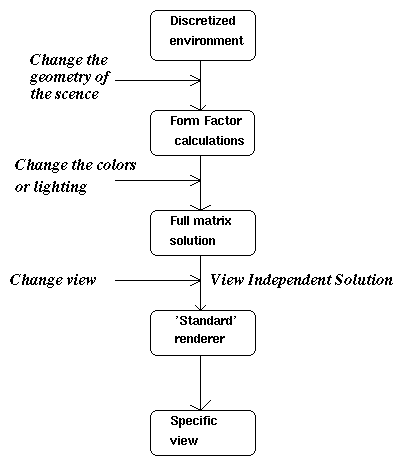 7.1. What is Radiosity?
7.1. What is Radiosity?  7.1. What is Radiosity?
7.1. What is Radiosity? Radiosity is a new photo-realism image synthesis technique in Computer Graphics. The method was based on heat transfer or interchange between surfaces. It was first introduced to Computer Graphics in 1984 by researchers at Fukuyama and Hiroshima Universities in Japan and at the Cornell University in America [Cohen,93]. The very first paper on radiosity was written by Goral [Goral,84] in 1984.
The Ray tracing method can produce impressive images even though it does not account for diffuse reflection of a ray. Ray tracing works best for modelling point light sources and specular reflections and refractions. It ignores the light interreflection between surfaces by substituting the term ambient == arbitrary constant. However, real environments are composed of diffuse reflected surfaces such as walls, carpets and so on. Therefore, the ray tracing method can be very disappointing for diffuse surfaces. Also we have to note that objects are illuminated not only by light emitters, such as light bulbs, but also by light reflected from other surfaces.
On the other hand, the radiosity method caters for
interreflection between surfaces, colour bleeding between
surfaces, penumbra along shadows boundaries and realistic
shadows. In the radiosity method, all the surfaces are assumed as
ideal (Lambertian) diffused reflectors. To calculate the
radiosity values of a scene all the surfaces of an environment
are broken into small elements (called patches). The transfer
radiant energy between each patch and every other patch is then
computed by using mathematical equations. By the law of radiation
heat transfer, each patch absorbs some of the light that reaches
it and reflects the rest back into the environment. Each
successive patch is treated as a potential light source and it
may also be considered as a light source more then once during
the process, in the case of multi interreflections. The process
is then repeated until the amount of energy transfer drops below
a specified limit.
Since the method precalculates the luminance (or photometric brightness), the user does not need to specify view parameters until the above process is completed. Then, the rendering algorithm is applied to perform the perspective transformation and determine the visual surfaces, and interpolate the precomputed shading data to produce the final image. Therefore, the radiosity method can offer view independent solutions. Of course, the final image depends on the selected view [Wallace,92].

Fig. 7.1 : The main stages in radiosity method
Traditional radiosity algorithms were restricted to environments in which all the surfaces could see each other. As research continued, the radiosity algorithms allowed for complex environments with occluded surfaces. The combination of the radiosity method and the ray tracing method not only caters for interreflection between surfaces but also accounts for glossy and mirror reflections. Thus, a combination of these two methods can produce the most dramatic pictures.
The most recent radiosity work is in the area of computational complexity of radiosity algorithm, parallelization and media participation.












